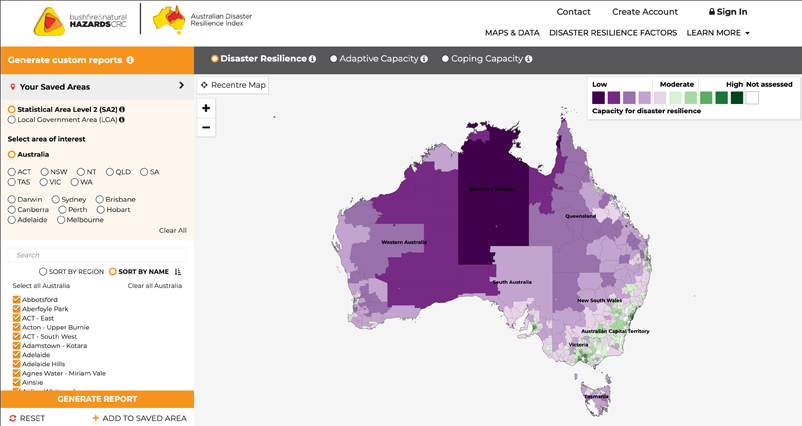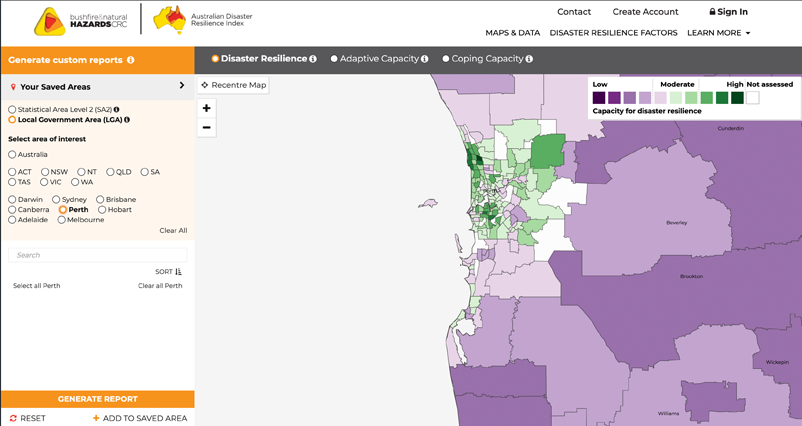An understanding of disaster resilience will help communities better prepare for, absorb and respond to natural hazards. A newly launched website helps explain and measure resilience so that we can adapt and transform our communities for the better.
People learn to live with a changing, unpredictable and uncertain environment, of which natural hazards are an increasing part. We are all developing ways to cope with, adapt to and recover from changes in our lives. But how does your community adapt and respond to change, and how can this process be improved? What resources does your community have at its disposal when responding to a natural hazard, and how could these be transformed so that your community recovers more easily and quickly, and is able to adapt its resources effectively so that it is better prepared next time?
Suellen Flint, the Deputy State Recovery Coordinator at the Department of Fire and Emergency Services (Western Australia) explains what makes a resilient community.
'At their best, communities are prepared, are able to adapt to changing situations, are connected to each other and are self-reliant,' said Ms Flint.
An understanding of disaster resilience focuses on ways that we can improve a community’s chance of adapting to future change, rather than focusing on its ability to react to hazards that have already occurred. To support resilience across Australia, a new research-based website, the Australian Disaster Resilience Index, has been developed to help industry, business, government and emergency services improve the resilience of their local communities before, during and after natural hazards.
Developed by the Bushfire and Natural Hazards CRC and the University of New England, the Index is free to use and allows anyone with an interest in understanding the resilience of their local community to access this information.
What does the new Australian Disaster Resilience Index do?
The output of six years of CRC research, the Australian Disaster Resilience Index provides a clear but detailed pathway to better understanding and measuring resilience across Australia, so that businesses, governments, not-for-profits and community organisations can improve their decision-making about planning, development, policy, engagement and risk assessment.
'The Index is capturing a national picture of disaster resilience,' said lead researcher of the Index, Dr Melissa Parsons at the University of New England. 'This national picture will help communities, governments and organisations further develop the capacities for adapting to and coping with natural hazards.'
The Index gives you everything you need to start exploring the resilience of your community, including an interactive map that generates data reports for specific areas, and information about the strengths and barriers to disaster resilience for each area. You can examine the resilience of your local community and start to plan for improved resilience.
It measures overall disaster resilience, as well as coping and adaptive capacity, by assessing eight key factors:
Coping capacity:
- social character (the social and demographic characteristics of the community)
- economic capital (the economic characteristics of the community, such as wealth or market health)
- emergency services (the presence and resourcing of emergency services)
- planning and the built environment (the presence of legislation, plans, structures or codes to protect the
- community and its built environment)
- community capital (the cohesion and connectedness of the community)
- information access (the potential for the community to engage with natural hazard information).
Adaptive capacity:
- social and community engagement (the capacity within the community to adaptively learn and transform in the face of complex change)
- governance and leadership (the capacity within organisations to adaptively learn, review and adjust policies and procedures, or to transform organisational practices).

Figure 1: The Australian Disaster Resilience Index provides a national picture of disaster resilience, with an interactive map, detailed reports and information about strengths and barriers to disaster resilience of each community.
Source: Bushfire and Natural Hazards CRC
Dr Parsons and her team have assessed these factors in each community and combined them to determine whether each community has high, moderate or low capacity for resilience.
Coping capacity is the means by which people or organisations can use available resources and abilities to face a hazard that could lead to a disaster. For example, if a community has high levels of economic capital, plenty of emergency services to use and good access to information, it has high coping capacity.
Adaptive capacity measures the arrangements and processes that are in place in the community to enable adjustment through learning, adaptation and transformation. For example, if a community has strong community engagement and governance, it has high adaptive capacity.
Applying an understanding of disaster resilience
Not all communities have the same capacity for resilience given the many social, economic and institutional factors that play a role. In fact, not even all communities within one area have the same level of resilience. This cross-community mosaic of resilience within larger areas can be used to identify strengths, form alliances and develop targeted improvements.
For example, if you use the Index to look at the overall resilience of the greater Perth area, you will see a range of resilience capacities within that area. This means that it’s not one-size-fits-all for areas such as Perth. Understanding the differences between communities within your area will help you understand where specifically to invest more resources and resilience-building initiatives.

Figure 2: The Australian Disaster Resilience Index provides views of the resilience capacities of large or small areas using local government areas and Statistical Area Level 2.
Source: Bushfire and Natural Hazards CRC
Five disaster resilience profiles
'What works in one place won’t necessarily work somewhere else,' Dr Parsons said, explaining that the improvements to resilience will look very different in different communities.
To explore this, the Index also proposes five disaster resilience profiles in Australia – nationwide collections of communities that all fit a similar profile of resilience strengths and constraints. These profiles provide an opportunity to address specific constraints and strengths of an area.
For example, local government areas in west Queensland, north western New South Wales, South Australia, Northern Territory and Western Australia all share a similar resilience profile. Once you can identify areas similar to the one you live in, you can start looking at what those areas have done to improve their resilience, and assessing whether a similar approach will work for your community. This also allows the opportunity for an open dialogue with other resilience partners, and the coordination of resilience-building initiatives and sharing of resources between areas.
'In some places, the capacity for disaster resilience comes from social strengths. These same places can also have constraints on disaster resilience because of lack of access to government services, telecommunications and low economic capital. In another place, the capacity for disaster resilience might come from the provision of emergency services or local and regional planning. But these places also face limitations from lower community connectedness,' Dr Parsons said.
The future of disaster resilience
The Index sets a new benchmark for measuring future changes in resilience to natural hazards and promoting resilience-building initiatives. By informing and supporting leaders in Australian organisations to better understand and measure resilience, those organisations will be able to enhance how they currently support communities before, during and after a natural hazard, thereby building a more disaster-resilient country.
While the Index can be specifically applied to fire and emergency services, it will also be of great value for business and industry, not-for-profit organisations and local, state and federal governments. It will be used to inform policy, resource planning, community profiling, strategic planning, emergency planning and preparedness, risk assessment and other crucial processes.
Ms Flint emphasises the importance of the Index for the emergency management sector. 'The ability to identify hot-spots of high or low disaster resilience in Australia and identify areas of strength in coping and adaptive capacity…will help to embed disaster resilience not only into policy and legislation, but to lead to an increase in shared responsibility and resilience across Australia,' she said.


